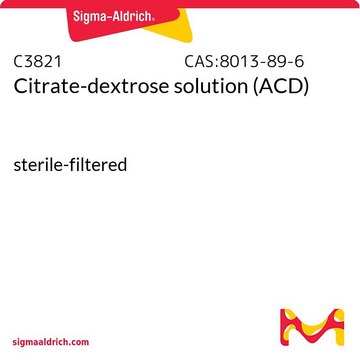C3434
Sodium citrate tribasic dihydrate
BioXtra, ≥99.0% (titration)
Synonym(s):
Citric acid trisodium salt dihydrate, Trisodium citrate dihydrate
About This Item
Recommended Products
product line
BioXtra
Quality Level
Assay
≥99.0% (titration)
form
powder or crystals
impurities
Insoluble matter, passes filter test
pH
7.5-9.0 (20 °C, 0.1 M in H2O)
mp
>300 °C (lit.)
solubility
H2O: 0.1 M at 20 °C, clear, colorless
anion traces
chloride (Cl-): ≤0.001%
sulfate (SO42-): ≤0.005%
cation traces
Al: ≤0.0005%
As: ≤0.00001%
Ba: ≤0.0005%
Bi: ≤0.0005%
Ca: ≤0.005%
Cd: ≤0.0005%
Co: ≤0.0005%
Cr: ≤0.0005%
Cu: ≤0.0005%
Fe: ≤0.0005%
K: ≤0.01%
Li: ≤0.0005%
Mg: ≤0.0005%
Mn: ≤0.0005%
Mo: ≤0.0005%
NH4+: ≤0.001%
Ni: ≤0.0005%
Pb: ≤0.0005%
Zn: ≤0.0005%
absorption
≤0.010 at 260 in H2O at 0.1 M
≤0.010 at 280
SMILES string
O.O.[Na+].[Na+].[Na+].OC(CC([O-])=O)(CC([O-])=O)C([O-])=O
InChI
1S/C6H8O7.3Na.2H2O/c7-3(8)1-6(13,5(11)12)2-4(9)10;;;;;/h13H,1-2H2,(H,7,8)(H,9,10)(H,11,12);;;;2*1H2/q;3*+1;;/p-3
InChI key
NLJMYIDDQXHKNR-UHFFFAOYSA-K
Looking for similar products? Visit Product Comparison Guide
Biochem/physiol Actions
Storage Class Code
11 - Combustible Solids
WGK
WGK 1
Flash Point(F)
Not applicable
Flash Point(C)
Not applicable
Personal Protective Equipment
Choose from one of the most recent versions:
Already Own This Product?
Find documentation for the products that you have recently purchased in the Document Library.
Customers Also Viewed
Articles
This is an article about how proliferatively active cells require both a source of carbon and of nitrogen for the synthesis of macromolecules. Although a large proportion of tumor cells utilize aerobic glycolysis and shunt metabolites away from mitochondrial oxidative phosphorylation, many tumor cells exhibit increased mitochondrial activity.
Information on fatty acid synthesis and metabolism in cancer cells. Learn how proliferatively active cells require fatty acids for functions such as membrane generation, protein modification, and bioenergetic requirements. These fatty acids are derived either from dietary sources or are synthesized by the cell.
Our team of scientists has experience in all areas of research including Life Science, Material Science, Chemical Synthesis, Chromatography, Analytical and many others.
Contact Technical Service
